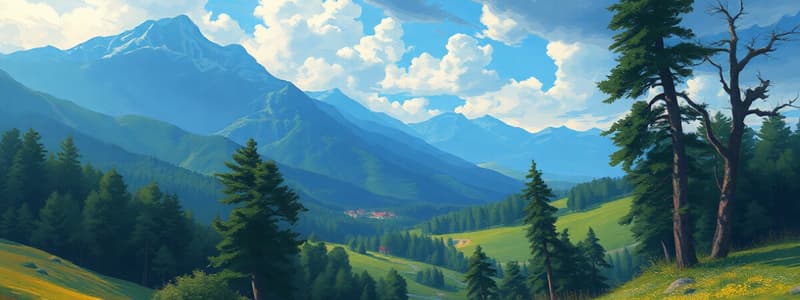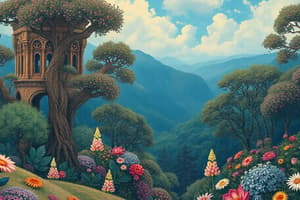Podcast
Questions and Answers
Which element is central to landscape painting, going beyond mere replication of a scene?
Which element is central to landscape painting, going beyond mere replication of a scene?
- Adherence to traditional color palettes
- The use of expensive materials
- Interpreting and conveying feeling (correct)
- Technical accuracy in depicting details
How does using a limited color palette contribute to a landscape painting?
How does using a limited color palette contribute to a landscape painting?
- Allows the introduction of contrasting elements.
- Creates a vibrant and diverse range of hues.
- Ensures the artwork remains affordable to produce.
- Promotes harmony and unifies the artwork. (correct)
In landscape painting, what is the purpose of dividing a scene into thirds?
In landscape painting, what is the purpose of dividing a scene into thirds?
- To make the painting easier to frame
- To ensure accurate proportions of objects
- To create balance and place key elements effectively (correct)
- To create a geometric pattern in the artwork
What role do 'leading lines' serve in landscape composition?
What role do 'leading lines' serve in landscape composition?
Why is it important to establish a focal point in a landscape painting?
Why is it important to establish a focal point in a landscape painting?
What does 'atmospheric perspective' achieve in a landscape painting?
What does 'atmospheric perspective' achieve in a landscape painting?
How does the use of warm and cool colors contribute to a landscape painting?
How does the use of warm and cool colors contribute to a landscape painting?
How does the impasto technique influence the look and feel of a painting?
How does the impasto technique influence the look and feel of a painting?
What effect does the scumbling technique typically produce in a painting?
What effect does the scumbling technique typically produce in a painting?
What distinguishes the 'palette knife' technique from other brushwork methods?
What distinguishes the 'palette knife' technique from other brushwork methods?
In creating depth and dimension with light and shadow, what does 'Chiaroscuro' involve?
In creating depth and dimension with light and shadow, what does 'Chiaroscuro' involve?
How does observing shadow shapes contribute to the realism of a painting?
How does observing shadow shapes contribute to the realism of a painting?
When learning landscape painting, what benefit does studying the works of Claude Monet provide?
When learning landscape painting, what benefit does studying the works of Claude Monet provide?
What aspect of J.M.W. Turner's seascapes is particularly instructive for aspiring landscape painters?
What aspect of J.M.W. Turner's seascapes is particularly instructive for aspiring landscape painters?
What unique contribution did Thomas Cole make to American landscape painting?
What unique contribution did Thomas Cole make to American landscape painting?
Besides talent, what is essential to developing painting skills?
Besides talent, what is essential to developing painting skills?
When starting to learn landscape painting, why is it important to spend time outdoors?
When starting to learn landscape painting, why is it important to spend time outdoors?
Why might an aspiring landscape painter seek feedback on their artwork?
Why might an aspiring landscape painter seek feedback on their artwork?
How does observing nature directly benefit a landscape painter, compared to only using photographs?
How does observing nature directly benefit a landscape painter, compared to only using photographs?
What is the key difference between replicating a landscape versus interpreting it through painting?
What is the key difference between replicating a landscape versus interpreting it through painting?
Flashcards
Landscape Painting
Landscape Painting
More than replicating a view; involves interpreting and conveying the feeling.
Elements of Nature
Elements of Nature
Capturing the beauty and power of natural elements; expresses artist's connection to the world.
Personal Expression
Personal Expression
Gives unique perspective and allows emotional reflection; reveals underlying narratives.
Rule of Thirds
Rule of Thirds
Signup and view all the flashcards
Leading Lines
Leading Lines
Signup and view all the flashcards
Focal Point
Focal Point
Signup and view all the flashcards
Warm and Cool Colors
Warm and Cool Colors
Signup and view all the flashcards
Color Palette
Color Palette
Signup and view all the flashcards
Atmospheric Perspective
Atmospheric Perspective
Signup and view all the flashcards
Impasto
Impasto
Signup and view all the flashcards
Scumbling
Scumbling
Signup and view all the flashcards
Palette Knife
Palette Knife
Signup and view all the flashcards
Light Source
Light Source
Signup and view all the flashcards
Chiaroscuro
Chiaroscuro
Signup and view all the flashcards
Shadow Shapes
Shadow Shapes
Signup and view all the flashcards
Study Notes
- Landscape painting aims to capture nature's essence on canvas.
Defining Landscape
- Landscape painting involves interpreting and conveying feeling, not just replicating a view.
- Capturing the beauty and power of natural elements in landscape painting expresses the artist's connection to the world.
- Landscape painting offers a unique perspective and allows emotional and creative reflection, revealing underlying narratives.
Composition
- The rule of thirds involves dividing the scene into thirds to create balance and placing key elements along these lines.
- Leading lines are used to guide the viewer's eye and are drawn deeper into the painting.
- Establishing a clear focal point draws the eye and creates a center of interest.
Color Harmony
- Warm and cool colors are used to create depth and convey emotion.
- Using a limited palette can create harmony and unify the artwork.
- Muted colors are used for distant objects to simulate the effect of the atmosphere.
Brushwork Techniques
- Impasto is applying thick paint to create texture and dimension.
- Scumbling uses a dry brush for soft texture, which is ideal for foliage.
- Applying paint with a palette knife allows for bold strokes, yielding unique texture.
Light and Shadow
- Identifying the main light source and establishing a realistic illumination pattern contribute to the painting.
- Chiaroscuro uses strong contrasts between light and dark to emphasize three-dimensional form.
- Observing the shapes of shadows will help define the forms of objects.
Famous Landscape Masters
- Claude Monet painted impressionistic landscapes that captured light and atmospheric effects.
- J.M.W. Turner painted dramatic and expressive seascapes, making sure to use color and light.
- Thomas Cole, founder of the Hudson River School, painted American landscapes.
Tips for Improvement
- Practice regularly by setting aside time for painting often to develop skills over time.
- Seek feedback by sharing art with others for review and learning from constructive comments.
- Spend time outdoors sketching and take reference photos to observe nature.
Studying That Suits You
Use AI to generate personalized quizzes and flashcards to suit your learning preferences.




